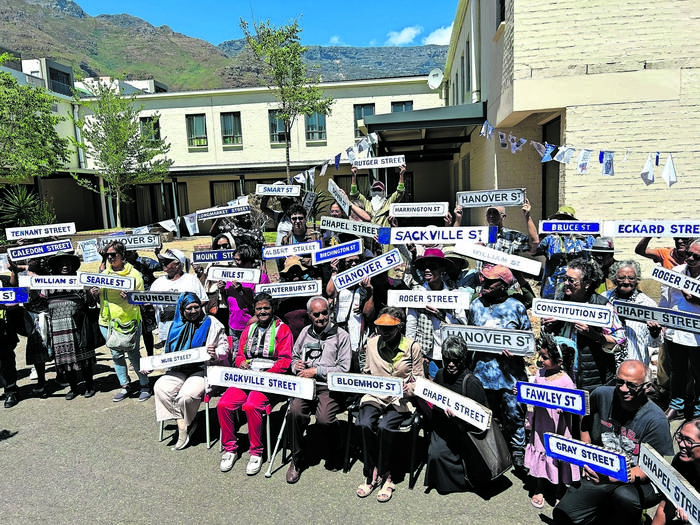
My street: Former and current District Six residents (above) gathered last month to commemorate 11 February 1966, the start of forced removals in the area.
11 February 1966, marks an important day in South African history. It was the start of forced removals in Cape Town’s District Six after it was declared whites-only under the Group Areas Act.
District Six was one of the first — and perhaps most famous — of the forced removal sites during apartheid but many other areas around the country would be affected.
Thirty years into its existence, the District Six Museum has a new executive director. Zeenat Patel-Kaskar officially took up the reins in January.
The museum lost its previous director Siddeeq Railoun in 2021 to Covid-19 complications.
Patel-Kaskar understands the importance of preserving memories for future generations, especially because of her own past.
During an interview in her new office at the Homecoming Centre, she said she had had a connection to the institution and the issue of forced removals since birth.
“I was born and bred in Simon’s Town. That was my family home.
“I was too young; I don’t recall much. What I do recall is living through severe trauma — my mom’s side of the family were forcibly removed from Claremont. That is prevalent in my life.”
She said her grandmother fell ill after the family left Claremont, in Cape Town’s southern suburbs.
“We moved to Rylands, as all Indians do,” she joked.
“I think my story of forced removals really comes from Claremont. Being a child going through this, you don’t really have the language. We didn’t understand anger. It was just like the adults spoke and we listened.
When her family had left Claremont, she still went back there every day to attend Livingstone High School. “You are removed but also not so at all. It’s a funny place to find yourself in.”
Her first insight into what was happening in the area was when she saw Casspirs — four-wheel drive troop transporters — coming down Belgravia Road, where she caught a bus to school.
“There was a lot of unrest. That was my first real experience of what a mass rally is; that’s what tear gas is.
“I didn’t understand things. Years later, I understand it now. I understand why photos are so important.”
For Patel-Kaskar, the issue of forced removals is still close to home.
“My mother is 89 and she has dementia. Her short-term memory is gone. Right now, she is a young girl living in Claremont. That is where she thinks she is.
“She talks Afrikaans all the time and I have an English-speaking home. She’s living it in her mind and in her heart. It’s the weirdest thing.
“About a year ago, my mom took all the black-and-white photographs.
“It looks like a museum in her bedroom. It’s all those lost photos.
“People think that it’s so long ago and should be forgotten but it’s not and it’s very real.
“Even when I sit with the former residents, it’s painful hearing what they have to say.”
After a short stint in the corporate world, Patel-Kaskar worked for philanthropist Mark Shuttleworth and for the Islamic Relief charity.
“When this opportunity to work with the District Six Museum came about, it triggered a lot for me. You can’t be a citizen of Cape Town, never mind South Africa, and not be connected to District Six Museum.”
 A Kaapse Klopse band played at the event.
A Kaapse Klopse band played at the event.On Saturday, 10 February, the museum hosted an event to commemorate the forced removals.
Former residents were part of the group that gathered at the Cape Peninsula University of Technology campus, where District Six houses once stood. There was a traditional Kaapse Klopse band, as well as an art exhibition curated by visual arts practitioner Ayesha Price and District Six residents who work with the museum. It was an emotional walk down memory lane.
The exhibition was a short distance away on a plot of vacant land where houses used to stand. There was scaffolding, a washing line and a broken piece of wall. There were also pillowcases hanging from pillars.
Art and storytelling are an important method of preserving memory. The commemorative day is not just about District Six but about all communities in the world that suffer land dispossession.
“I look at the number of claimants over the years who have received compensation in some way. It speaks volumes to this missing batch of people. I wonder if they’re ever going to get any kind of compensation,” said Patel-Kaskar.
The future of the museum will be a major focus of Patel-Kaskar’s tenure, particularly in this important year for the museum and for the country, 30 years into democracy.
The museum almost did not survive the Covid-19 lockdowns. It is because of a crowdfunding campaign and donations from the community that its doors are still open.
“A large part of the funding that sustains the work is the entrance tickets and sales that we make.
“During Covid, that all stopped, and the museum found itself in a very precarious situation. We heard the desperate pleas on the radio.
“I think what was amazing was the response of the public.”
On the day of the interview, the museum was expecting a visit from the Palestinian football team, in the country to play exhibition games.
“The commemorative day on 11 February has never only been about District Six. How do you disconnect what happened here from what is happening in the world?
“We are living through the biggest global mass eviction and humanitarian disaster and we are fighting about it in court. Are we going to sit back 30 years from today and have the same conversation about it? There’s going to be nothing left.”
Patel-Kaskar said the museum still had a lot to do, especially getting younger people involved. She also called on more funding support.
“I want to remind the private sector — and the public sector — to support our work. There is so much support you can do and there is so much work that needs to be done.
“Come to our programmes — you will walk away enriched.”
 (1).png)
 9 months ago
29
9 months ago
29


















